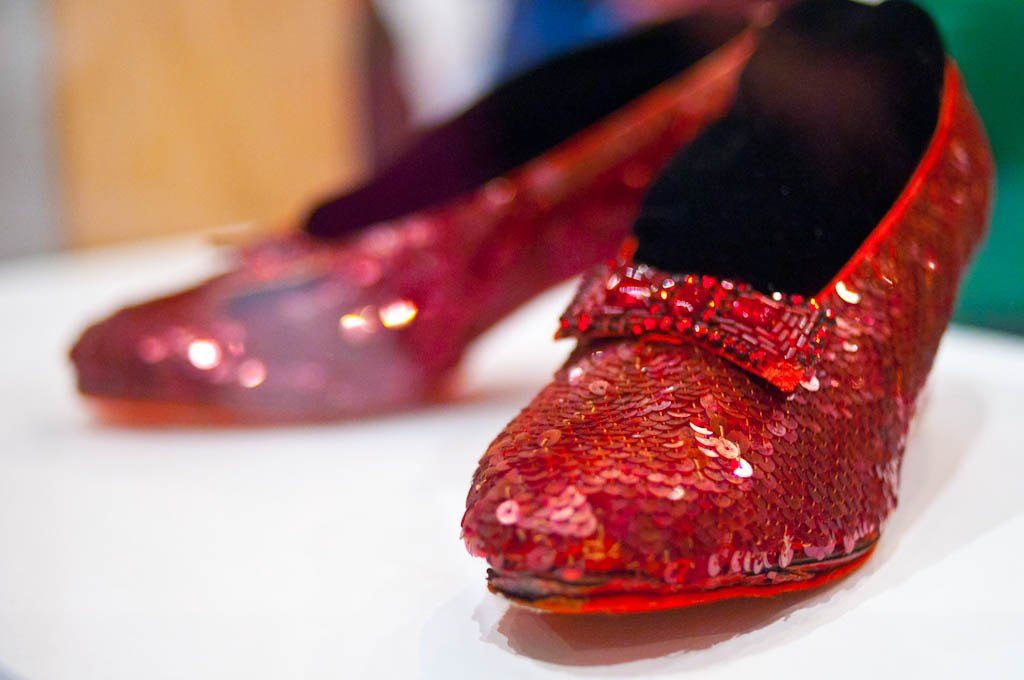The Ruby Slippers from the 1939 masterpiece The Wizard of Oz continue to capture the imaginations of the young and old alike. How we sometimes wish we could be transported home by clicking our heels thrice and saying “there’s no place like home!”. Several pairs of these iconic slippers were used during filming; over the years, some were stolen, some were lost, and some changed hands and attics. In late October last year, one pair of Dorothy Gale’s Ruby Slippers returned for public viewing at the Smithsonian’s National Museum of American History. After more than a year of meticulous sequin-by-sequin restoration and conservation treatment, Janet Douglas and her team of conservationists from the Smithsonian Institution are determined to keep this pair sparkly for several generations to enjoy.
This conservation campaign was crowdfunded under the handle #KeepThemRuby. It was important for the research team to first extract detailed information about the slippers to understand their current state. In the nearly 80 years of its existence, this pair, thought to be the primary pair worn by Judy Garland to film dance scenes, has been almost continuously on display since it was donated to the museum in 1979. Due to aging and the unknown conditions under which this pair was stored for the first 40 years, the slippers showed visible signs of physical deterioration and discoloration.
These famous ruby slippers were actually a simple pair of store-bought pumps which were dyed red and decorated with a sequined netting, bows, colored stones, and beads, among other materials. The researchers used a bouquet of minimally invasive and non-invasive analytical techniques to study the many parts of the slippers without damaging them. In this case, “non-invasive” means that the technique does not require researchers to damage the shoes to analyze them.
To analyze the features of the shoes in detail, scientists used a popular technique called micro-X-Ray fluorescence spectroscopy. In this technique, a beam of X-rays are directed at the ruby slippers. When struck, the materials emit light of a distinct energy that is then measured to identify the chemical elements (carbon, nitrogen, metals, etc.) in the slippers. Using this technique, the researchers analyzed most materials of the slippers, including the sequins, red paint, felt, and heel materials. They were also able to determine whether the beads and rhinestones used in both slippers were identical. This revealed if they were the original materials or patchwork repairs.
With the help of infrared spectroscopy, similar in concept to the X-ray technique but using infrared (like heat) energy instead, they were able to determine the chemical makeup of the slipper materials. They identified several adhesives that may have been used to glue the embellishments to the slippers.
Polarized light microscopy helped them identify the various fibers used in the slippers – silk, cotton, and orange-dyed wool. This technique provides high-quality images with the help of polarizing filters, and makes use of the inherent nature of most solid materials. One way to imagine how this technique works is to think about polarized sunglasses. If you orient them one way, they block light. If you orient them another way, they allow light to come through. When materials are hit with light, they may only release light oriented in a certain direction like the sunglasses. That direction, it turns out, is specific to the material and can be used to identify it.
Finally, with chromatography, they determined that the red dye used for the materials was Rhodamine B, which is widely used in dyeing textiles and printing paper. Chromatography is a way of separating a mixture of colored chemicals, such as what was extracted from the slipper, by allowing them to travel down a column. Each chemical will stop at a different place on the column, and then researchers can easily remove the substance and identify it.
Interestingly, they also found that the sequins had a layered structure — protein at the bottom, a thin silver coating, and the red dye. The silver coating, which may have been used to enhance the reflective effects of the slippers, had made the sequins appear black over time. The research team believes this silver degradation can be prevented by simply placing substances that remove impurities in the slippers’ display case.
In the words of Sir Francis Bacon, knowledge is power. Using the detailed information on each material in the slippers, the researchers then determined the ideal temperature, relative humidity, and light intensity that would prevent further deterioration of the shoes. They concluded that 65°F, 45–50% relative humidity, and 30 lux/3 foot-candles would be acceptable conditions. The researchers hope to be able to fine-tune these environmental conditions to their most ideal levels, while keeping down costs, and hopefully, #KeepThemRuby forever!


